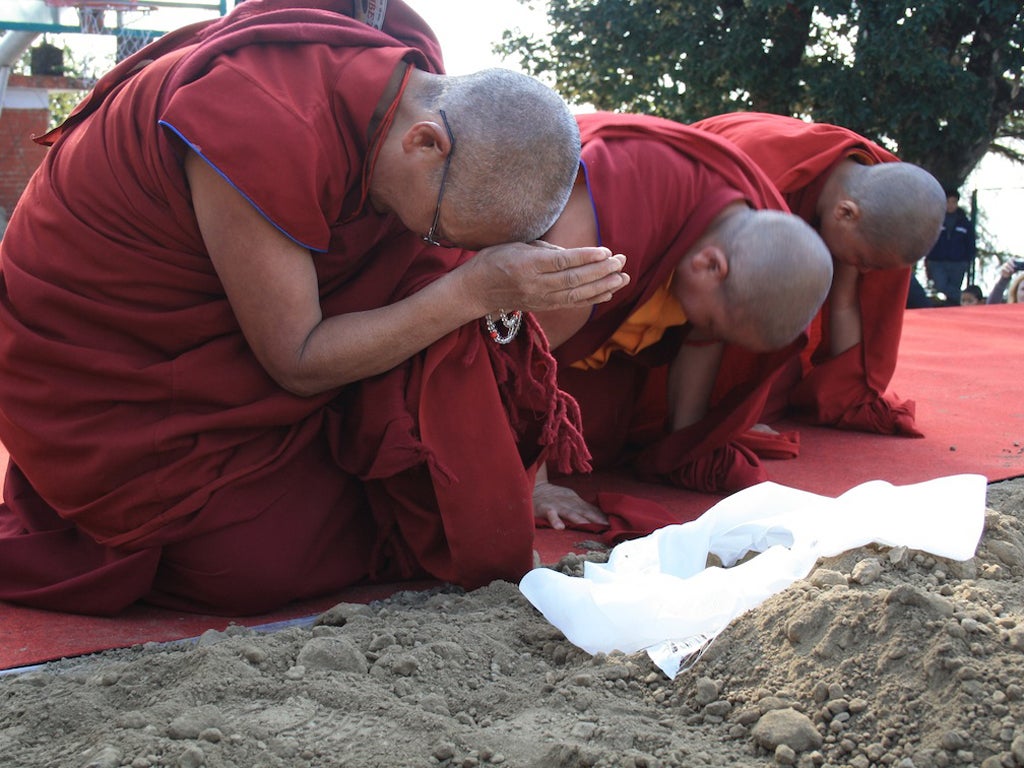The Tibetan monks back on home soil
A daring artist has given exiles in India a chance to tread the ground of their native land once more – by smuggling 20 tonnes of it across the border

Some took a handful and placed it in a shrine kept in their homes, others poured a little into a pouch that they looped around their necks on a string, while the office of the Dalai Lama dispatched a jeep and gathered a sack-full.
Everyone wanted to get their hands on some Tibetan soil.
The recent distribution of 20 tonnes of the pale-coloured earth by a Tibetan artist in Dharamsala marked the conclusion of an intriguing project that was part-art installation and part-smuggling operation. Inspired by the regret expressed by his gravely ill father that he would never again walk on Tibetan soil, the artist Tenzing Rigdol decided to arrange for the earth instead to be taken to those Tibetans living in exile. The result was the installation upon which Mr Rigdol encouraged people to tread.
"My dad and other relatives would say that, before they died, they wanted to step [once more] on Tibetan soil," said Mr Rigdol, born in India and now based in New York. "After my father passed, I remembered what he had said."
Gradually, the artist hatched a secret plan to collect the soil from a location "deep inside Tibet" and bring it to Dharamsala via Nepal, in three lorries. Even now, Mr Rigdol asks that the full details of the operation – a story which may subsequently be made into a documentary – are not revealed in order to protect those who helped him do it. For the same reason, he is disinclined to reveal precisely where in Tibet the soil came from. He didn't want people in Tibet to think he had deliberately selected one area over another.
But the details he is happy to reveal suggest a complex and carefully planned undertaking that required tricking border guards, paying numerous bribes and the creation of convincing cover stories to persuade any official who pried too closely that all was well. In addition to changing the sacks bearing Chinese writing in which the soil was initially bought, Mr Rigdol's team had to switch lorries on six occasions to ensure they used vehicles with the appropriate licence plates. The final change was when they entered the state of Himachal Pradesh in which Dharamsala is located.
It would have been much easier had he arranged to have just a small, token amount of soil delivered. But he said it was always important to him that the project he envisaged had an appropriate scale. "If something is huge, people can become engulfed by it... I wanted them to respond on an emotional level," explained Mr Rigdol, whose soil installation measured 30ft by 30ft. "If it was just one bag, it would not have brought out people's emotions."
For the Tibetans of Dharamsala, home of the refugee and exile community since the Dalai Lama fled Tibet in 1959, the project struck a powerful chord. While hundreds of Tibetans still make their way out of Tibet every year in protest at what they describe as the authoritarian actions of the Chinese authorities, many in this town in the foothills of the Himalayas were born here and have no personal experience of Tibet, apart from the stories told to them by their parents. For them, the opportunity to place their feet on Tibetan soil for the first time was compelling.
For a community weighed down by the lack of progress made by the Tibetan freedom campaign, and by the recent, unprecedented wave of self-immolations by monks and nuns inside Tibet, the project bore an optimistic message. "It was amazing. There was a lot of positive energy," said Tenzin Dhondup, a Dharamsala-based activist who was involved in the project.
The response from the people who visited the installation, uncertain what to expect, and walked on the soil was remarkable. Some wept, some prayed, while a number of Buddhist monks knelt down and blessed the earth. Elderly people who were born inside Tibet visited with their children or grandchildren. Spontaneously, people began walking clockwise around the soil, an act of devotion known in Buddhism asperforming the kora. A tub of the earth was sent to the Dalai Lama; it was returned with the word "Tibet" drawn by a finger in the Tibetan script.
"I was there the first morning. People were crying and getting very emotional," said a young man, who works at a guesthouse in the town. "I was born in India. This was the chance to walk on Tibetan soil."
Mr Rigdol had chosen to set out the soil on a stage erected on the outdoor basketball court at Dharamsala's Tibetan Children's Village school, which he had attended as a teenager. On a recent afternoon, the court was busy with young people playing and watching. Many of them had visited the project.
"It was there for three days and on the last day he gave everyone a handful of soil," said Sankyi, an 18-year-old woman who came from Lhasa in 2003. "There are so many people here who were born in India. At least those persons can now say 'I walked on Tibetan soil'. Everyone walked on it."
Among her friends was a young man born in Dharamsala. Like the others, he had also walked on the soil and taken a handful home, placing it inside the shrine kept by his family. He said the event had been one of the most memorable days of his life. He said: "I felt good ... walking on the earth of my country."
Join our commenting forum
Join thought-provoking conversations, follow other Independent readers and see their replies
Comments